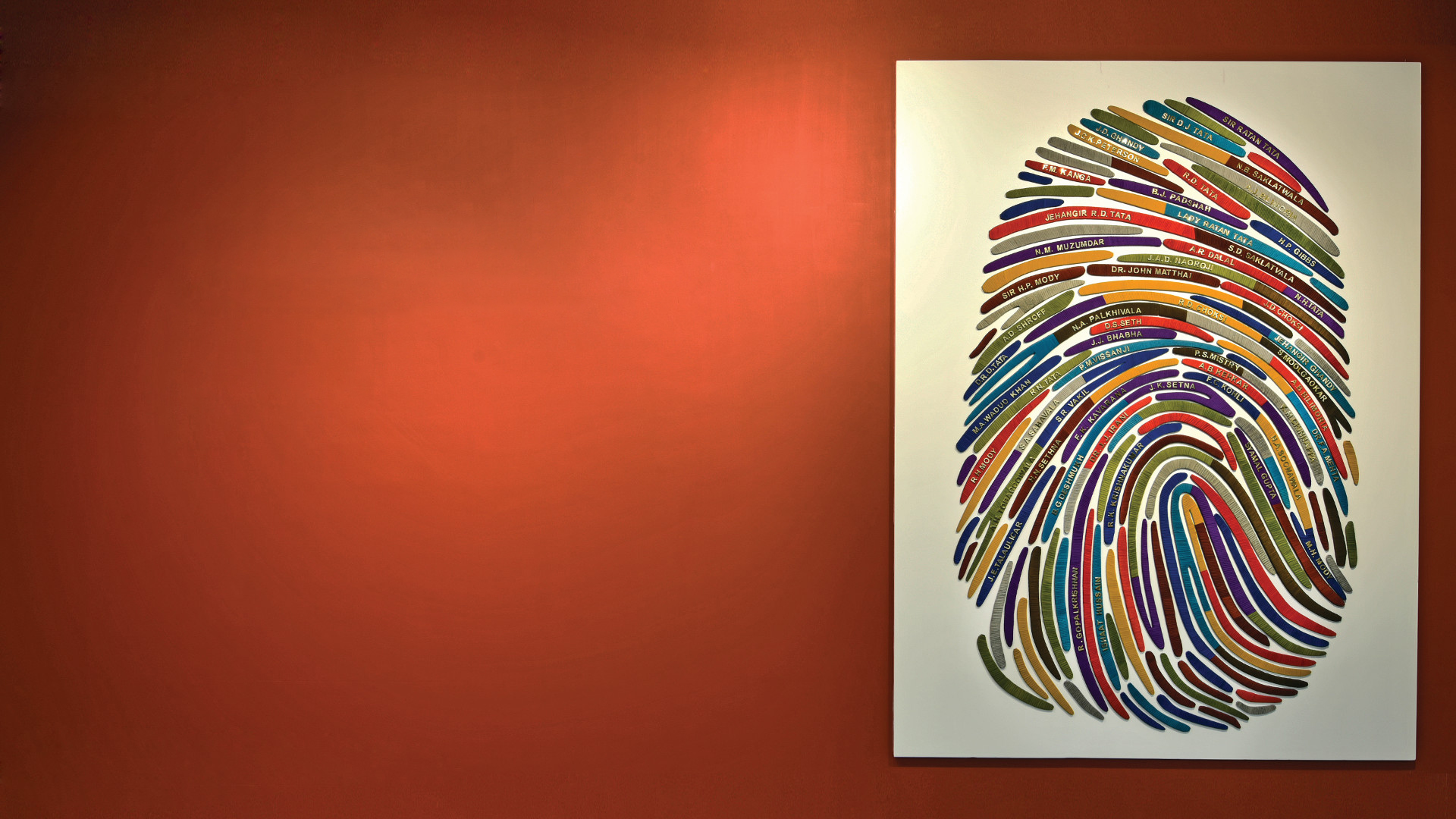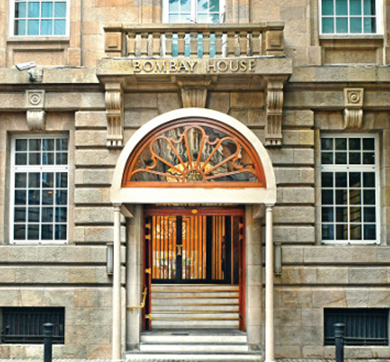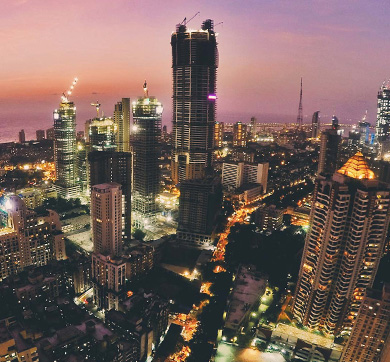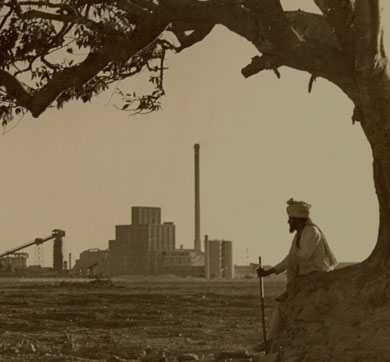September 2018 | 880 words | 3-minute read
Designing the art walls at Bombay House involved specific techniques of abstraction, application and the use of local arts and crafts to create a singular dynamic piece. The concept design was an outcome of discussions with individual companies and a collaboration with Baaya Designs.
These art walls reflect the ethos and values of the companies in a different way, merging the idea of corporate branding within the dedicated workspaces. They were designed and executed using material sourced from the companies.
A DNA Sequence Called TATA Box!
For Tata Sons, the design concept was to create an ‘Imprint’, a piece of art that symbolises its identity as the holding company of the Tata group. A thumb impression is a unique identity of an individual, so a large thumb impression was designed for this office. It represented the dynamic identity of Tata Sons, which is known for its entrepreneurial success, its pioneering efforts as well as its contribution to the community and the nation. This impression carries the names of each of the directors who contributed to build this legacy over a period of time.
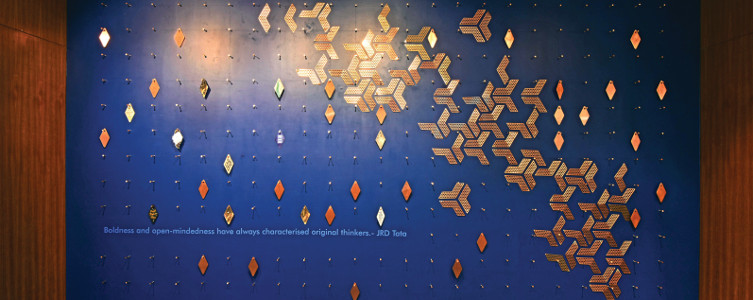
When the team began research and design on the concept of the company’s DNA, we found that there is a DNA sequence called the TATA box, which is found in the promoter region in human genes. Approximately 24 percent of human genes contain a TATA box within the core promoter. As the holding company, Tata Sons symbolises the DNA of the Tata group that promotes and binds the various companies towards the common vision of One Tata.
This concept was integrated into a textile art installation, which is manually dyed and hand woven as per the bands of the TATA box sequence represented on a diagram that depicted the details of each coloured band within the sequence. The process was guided by Ratna Krishnakumar and executed by Vinay Narkar Designs.
Turning steel into art Tata Steel was one of the first companies established by the Tata group. With its establishment came the first planned industrial city in India — the steel city of Jamshedpur. With this as the base for the art wall, and using cold rolled steel sheets from Tata Steel, a large steel skyline was abstracted from the iconic skyline of the Jamshedpur steel plant. This steel skyline was superimposed on the plan of the steel city of Jamshedpur.
The various other milestones of Tata Steel have been composed on the two adjacent walls as a reflection and reminder of its rich history.
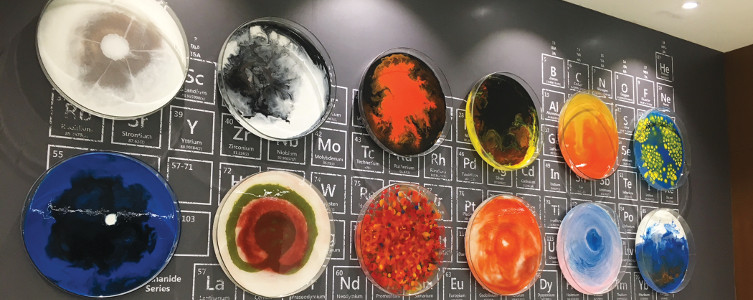
The Idea Of Power
Two art walls were designed for the Tata Power office. Along with steel, one of the dreams of Jamsetji Tata was to generate clean power, and this led to the great hydroelectric ventures in the Western Ghats. The design concept drew inspiration from the founder himself — a composition of iron nails, with its undulations and variations, came together to create a three-dimensional portrait of him.
For the second Tata Power art wall, the use of dynamic forms and colour were introduced to reflect the future of power generation and distribution. The company organised a drawing competition for children in order to capture the thoughts of young minds with relation to this idea of power.
Of Society And Science
The design concept for the Tata Chemicals art wall reflects the idea of ‘Serving society through Science’. The work that Tata Chemicals undertakes is abstracted and reflected into individual multi-coloured resin art pieces on glass petri dishes composed on a background of Mendeleev’s Periodic table. Each petri dish reflects important associations and contributions that Tata Chemicals has made to society. For examples the production of packaged iodised salt in Mithapur, making of glassware and saving the endangered species of whale sharks found on the shores of Gujarat.
Connecting Aspirations
Two adjacent walls were designed for Tata Motors — one reflecting the signature jaali of Tata Motors and the other with the world map. Designed by the Tata Motors team themselves, this art wall is inspired from their tagline: ‘Connecting Aspirations’ of individuals, cities and nations.
Upon receipt of the design it was up to our team to build their vision.
To create a wall that displays a memory, a prayer, a thought, a wish and an aspiration — the decision to use copper leafing was taken. Over time as the copper oxidises new textures and new colours will form giving the walls a new look every day, almost like a living finish.
Another element introduced by Tata Motors was the “Aspiration Diamonds”. These were designed and sent out to charities, schools, colleges and employees. Each diamond will be returned to Tata Motors with illustrations and words describing their aspirations and will be hung on the two walls creating a jaali pattern of its own. The walls are dynamic and change and grow over time.
Introducing the vision of individual Tata companies through the innovative ‘art walls’ — reflecting their ethos and values — and with the design of break-out spaces and common facilities with bursts of colour and graphics, we have aimed to create a vibrant ambience to engage the users within the workspace.
Author Brinda Somaya is the founder of Somaya and Kalappa Consultants. Over the course of four decades as an architect and urban conservationist, she has restored, recycled and retrofitted many heritage buildings in Mumbai, but Bombay House, she says, will always remain a landmark project for her.




